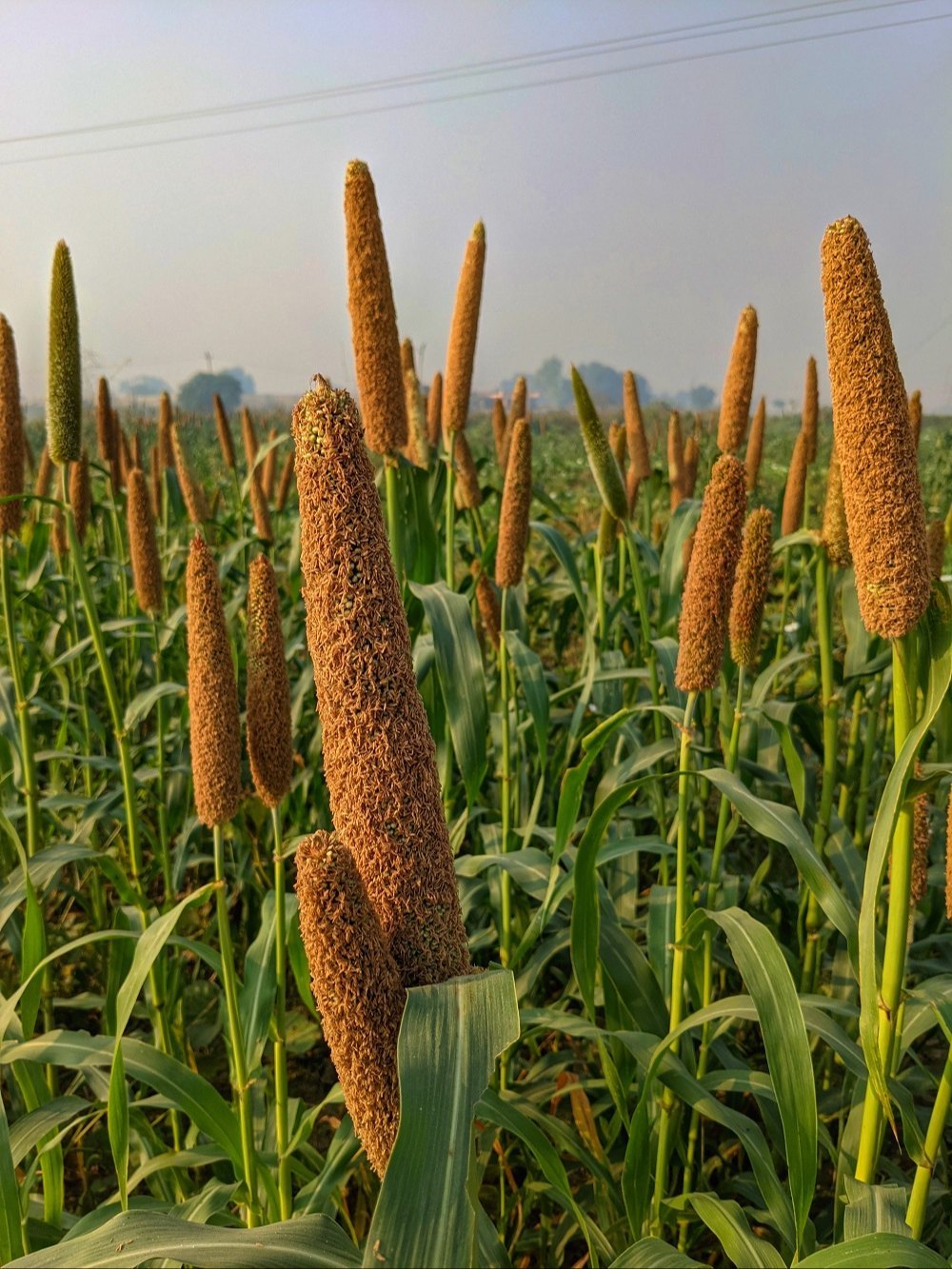Pearl Millet / Kambu / Bajra seeds
Pearl Millet / Kambu / Bajra seeds
Quantity: 250 grams
Growing Kambu millet from seeds organically is a straightforward and rewarding process. Whether you are growing it for personal consumption or selling the harvest, Kambu millet is a highly nutritious and sustainable crop that thrives in dry conditions and requires minimal care.
Order our premium Kambu millet seeds today and start growing this drought-resistant, nutrient-rich grain in your garden or farm. Grow a healthier, more sustainable future with organic Kambu millet!
Pearl Millet / Kambu / Bajra seeds
How to Grow Kambu Millet (Pearl Millet) from Seeds Organically: A Complete Guide
Kambu Millet, also known as Pearl Millet (Pennisetum glaucum), is a highly nutritious and hardy grain widely grown across the world, especially in India, Africa, and Asia. Known for its excellent protein, fiber, and iron content, Kambu millet is an excellent choice for people looking to improve their diet and live a sustainable, eco-friendly lifestyle. Growing Kambu millet organically is a simple yet rewarding process, and with the right care, you can enjoy a bountiful harvest of this versatile and nutrient-rich grain.
If you are looking to cultivate Kambu millet in your organic garden or farm, our Kambu millet seeds are a perfect choice to get started. Whether you’re a beginner or an experienced grower, this guide will walk you through the steps to grow Pearl Millet organically from seeds.
Why Grow Kambu Millet (Pearl Millet) Organically?
Growing Kambu millet organically offers several advantages:
- Highly Nutritious: Kambu millet is rich in fiber, iron, magnesium, and calcium, making it an excellent choice for improving bone health, regulating blood sugar, and boosting overall nutrition.
- Drought-Resistant: Kambu millet is extremely drought-tolerant, making it an ideal crop for regions with limited rainfall or areas prone to dry spells.
- Minimal Care: This millet requires less water, less fertilizer, and fewer pest control measures compared to many other crops, making it well-suited for organic farming.
- Soil Health: Kambu millet improves soil health by reducing erosion and enhancing soil structure, contributing to sustainable farming practices.
- Gluten-Free: For those following a gluten-free diet, Kambu millet is a great alternative to wheat and other gluten-containing grains.
Step-by-Step Guide on How to Grow Kambu Millet from Seeds Organically
1. Choose the Right Location for Growing Kambu Millet
Kambu millet thrives in warm, dry climates, and is highly adaptable to various soil types. Here’s what to keep in mind when selecting a location:
- Temperature: Kambu millet grows best in temperatures ranging from 25°C to 35°C (77°F to 95°F). It is a heat-tolerant crop that performs well in hot weather, making it ideal for regions with a warm climate.
- Sunlight: Kambu millet requires full sun for optimal growth. Choose a location that receives at least 6–8 hours of sunlight per day.
- Soil Type: Kambu millet prefers well-draining soil, but it can tolerate a wide variety of soil types, including sandyand loamy soils. It grows well in slightly acidic to neutral soil (pH 6.0 to 7.5).
2. Prepare the Soil for Planting Kambu Millet
Preparing the soil properly is crucial for a successful millet crop. Follow these steps to get the soil ready:
- Soil Fertility: Mix compost or well-rotted manure into the soil to improve organic matter and nutrient content. This will provide the necessary nutrients to the millet plants throughout the growing season.
- Soil Drainage: Ensure the soil is well-draining to prevent waterlogging, which can lead to root rot. Raised beds or mounds are ideal for Kambu millet to improve drainage.
- Tillage: Loosen the soil to a depth of around 4–6 inches before planting. This allows for better root development and seed penetration.
3. Sowing Pearl Millet / Kambu / Bajra seeds
Planting Kambu millet from seeds is easy. Here’s how to do it effectively:
- When to Plant: The best time to plant Kambu millet is during the pre-monsoon or summer season, when the soil temperature is warm enough to encourage germination.
- Seed Depth: Sow Pearl Millet / Kambu / Bajra seeds about 1–2 inches deep into the soil. This depth ensures that the Pearl Millet / Kambu / Bajra seeds are adequately covered, while still allowing for proper germination.
- Row Spacing: Plant the Pearl Millet / Kambu / Bajra seeds in rows spaced about 12–18 inches apart. This spacing gives the plants enough room to grow and spread.
- Seed Rate: For optimal coverage, sow 10-12 kg of Pearl Millet / Kambu / Bajra seeds per acre. If growing in a smaller garden or plot, you can adjust accordingly to fit your space.
4. Watering and Moisture Management
Kambu millet is drought-resistant but requires proper watering, especially during germination and the early stages of growth:
- Initial Watering: After sowing the Pearl Millet / Kambu / Bajra seeds, water the soil lightly to moisten it. Keep the soil consistently moistduring the germination phase, but do not overwater.
- Post-Germination: Once the plants are established, reduce watering. Kambu millet is a dryland crop and can withstand long periods of drought once established. Water only when necessary, especially during flowering and grain formation.
- Watering Frequency: If there is little rainfall, you can water once every 7-10 days. Ensure that the soil does not remain soggy or waterlogged.
5. Fertilizing Kambu Millet Organically
Fertilization is key to providing the nutrients needed for healthy growth:
- Compost and Organic Fertilizers: Apply compost or vermicompost to the soil before planting. This helps provide slow-release nutrients to the millet throughout the growing season.
- Green Manuring: You can practice green manuring by incorporating nitrogen-fixing plants like cowpea or soybean into the soil. This helps enrich the soil with nitrogen and promotes healthier growth.
- Avoid Chemical Fertilizers: Stick to organic fertilizers to ensure the health of your soil and the sustainability of your farming practice.
6. Weed Control
Weeds can compete with Kambu millet for nutrients and space, so effective weed management is crucial:
- Mulching: Apply a layer of organic mulch, such as straw or leaves, around the plants. This helps suppress weed growth, retain moisture, and improve soil quality.
- Manual Weeding: Regularly remove weeds by hand or use a hoe to gently uproot them. Weeding during the early stages of millet growth will give the plants a better chance to establish themselves.
7. Pest and Disease Control
While Kambu millet is relatively pest-resistant, occasional problems can arise. Here’s how to manage pests and diseases organically:
- Neem Oil: Use neem oil or a neem-based pesticide to control common pests such as aphids, cutworms, and grasshoppers.
- Fungal Diseases: If you notice fungal issues like powdery mildew, treat the plants with an organic fungicide or a simple baking soda solution to prevent further spread.
- Companion Planting: Consider planting marigolds or garlic near the millet to help repel pests naturally.
8. Harvesting Kambu Millet
Kambu millet is typically ready to harvest in about 3 to 4 months from sowing, depending on growing conditions.
- When to Harvest: Harvest when the millet heads are dry, and the grains are firm. The grains will be golden-brown, and the heads will be hard and dry to the touch.
- Manual Harvesting: Use a sickle or scythe to cut the millet heads. After cutting, allow the grains to dry in the sun for a few days before threshing.
- Threshing: After the millet has dried, separate the seeds from the stalks by hand or using a manual thresher.
Why Choose Our Kambu Millet Seeds?
If you’re looking to grow Kambu millet organically, our Kambu millet seeds are the perfect option for your farm or garden. Here’s why:
- Organic Growing: Our seeds are ideal for those looking to cultivate millet in an organic, chemical-free environment.
- Healthy and Nutritious: Kambu millet is packed with fiber, iron, and calcium, offering a highly nutritious and gluten-free grain that supports better health.
- Drought-Resistant: Kambu millet is highly adaptable to dry conditions, making it a great crop for regions with limited rainfall or water restrictions.
- High Germination Rate: Our seeds offer a high germination rate, ensuring your millet crop has the best chance of success.
- Low Maintenance: Kambu millet requires minimal care, making it a low-maintenance crop for sustainable farming.
Conclusion
Growing Kambu millet from seeds organically is a straightforward and rewarding process. Whether you are growing it for personal consumption or selling the harvest, Kambu millet is a highly nutritious and sustainable crop that thrives in dry conditions and requires minimal care.
Order our premium Kambu millet seeds today and start growing this drought-resistant, nutrient-rich grain in your garden or farm. Grow a healthier, more sustainable future with organic Kambu millet!
| Weight | 300 g |
|---|







Reviews
There are no reviews yet.